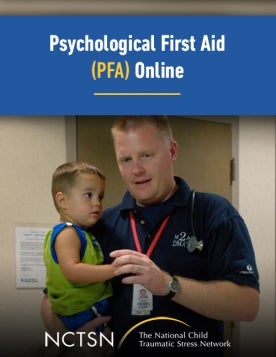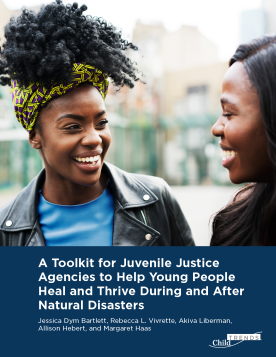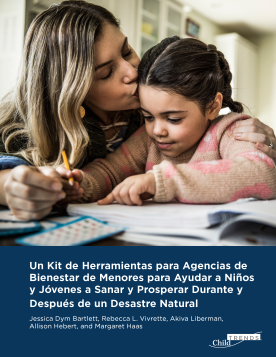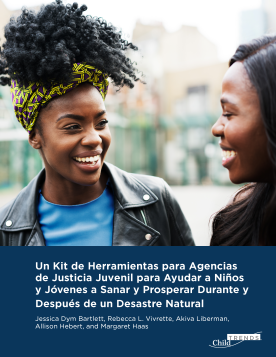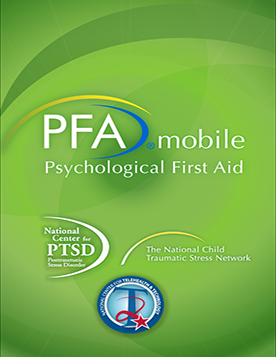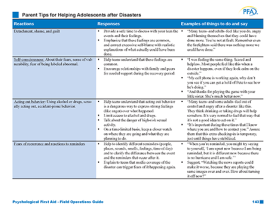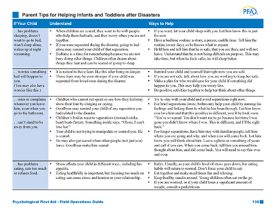Floods are the most common natural weather event and are temporary conditions when an area is overcome by water or mudflow. Floods occur under many conditions including: hurricanes, tsunamis, overtopped levees, snowmelt, overflowing drainage systems, and heavy rainfall. They most commonly affect those who live or work in low-lying areas, near water, behind a levee or downstream from a dam—areas where water can accumulate, overflow, or be quickly released. Most floods occur over a period of days and in the same region, providing time for formal warnings and preparation. Others, such as flash floods, may occur rapidly and without warning.
Being prepared beforehand is the best way to help children and families recover after a flood. To improve their preparedness, families should:
- Be informed about their flood risk, how to access updated official flood information, and the best evacuation routes. Families should know areas at risk for seasonal or flash flooding and landslide-prone areas; which official websites, radio stations, or social media will provide emergency information; what documents and possessions to bring if needing to evacuate; and whether they have adequate flood insurance. Encourage families to contact local authorities if they have any members who have ongoing health concerns or mobility issues or if they will need assistance during an evacuation. Help families to learn the different flood alerts:
- Flood Watch: Indicates that an overflow of water from a river is possible for the watch area.
- Flash Flood Watch: Indicates that flash flooding is possible in or close to the watch area. They may last as long as 12 hours as heavy rains move into and across the area.
- Flood Warning: Indicates flooding conditions are occurring in the warning area, and those in the warning area should evacuate to higher ground.
- Flash Flood Warning: Indicates flash flooding is occurring in the warning area, and those in the warning area should evacuate to higher ground.
- Assemble an emergency go kit. Families should have access to enough water, food, and other emergency supplies for at least 3 days and medications for at least 7 days. Families should also gather important documents, a battery-powered or hand crank radio, and supplies for pets. Keep supplies in a large backpack or easy to carry container in the event the family has to evacuate quickly.
- Prepare your property. If you live in a flood prone area, keep sandbags and appropriate cleaning supplies available. Also identify potential home hazards and plan to address them if flooding occurs. For example, know how and where to shut off power or gas.
- Make a family preparedness and communication plan. Since flooding can happen quickly and when families are not together, it is important to have a family communication plan for who to contact during a storm. This includes identifying an out-of-state/area loved one if communications are difficult in the area. Families should have important contact information easily accessible, identify who they can stay with in the event of an evacuation, and plan for sheltering pets and livestock. Families should identify areas around the neighborhood that are elevated and practice these evacuation routes together. Review the family preparedness plan and fill out the preparedness wallet card.
- Plan for children’s needs. Families should give children factual information about floods in simple terms, including how beneficial some floods can be for the ecosystem. Encourage parents to include children and their babysitters in preparedness activities. Families should also learn about their children’s school or after-school program emergency plans. The mobile app Help Kids Cope provides information on how to talk with children of different developmental levels.
Knowing what to do during a flood can help families feel more in control and take steps to increase their safety. Families should consider the following when responding to a flood.
When not in an evacuation zone, families should:
-
Monitor emergency alerts and stay informed about current weather updates.
-
Check their emergency supplies are updated and prepare for possible evacuation. Families should ensure they have food and water, documents, personal needs, and possessions in one location easily taken if needed. Families should keep cell phones fully charged and know evacuation options. If needing to share a ride, identify potential pick up areas. Be prepared to shut off utilities.
-
Move important items to upper floors or off the ground if there is a concern their home might get flooded.
During an evacuation, families should:
-
Gather their emergency go kit, all loved ones, and pets and evacuate. Families should evacuate when ordered and follow official evacuation routes if it is safe to leave by car. They should be discouraged from driving through flooded roads. If needing to share a ride, families should go to the pickup location. If it isn’t safe to evacuate by car, families should evacuate to a neighbors’ home or the nearest high ground.
-
Locate a designated public shelter if needed. Families can text SHELTER and their zip code to 43362 (4FEMA) to find the nearest open shelter. They can also download the American Red Cross Shelter Finder app
-
Leave their property secured. Families should turn off utilities and unplug appliances if time permits. They should implement a plan for pets and livestock if they cannot evacuate with them.
-
Inform other family members when safely out of the flood threat.
Immediately after the flooding has stopped or the water has receded, families should:
-
Know about health risks: Immediately after a flood, small children, pregnant women, and people with health problems should avoid the flooded area until the cleanup is complete. Families should keep children away from areas still flooded as floodwaters can contain hazards, bacteria, and chemicals.
-
Be aware of potential hazards. Families should watch for wild animals seeking refuge in homes and downed power lines. They should check for structural damage before re-entering their home and keep the power off until an electrician has inspected the property and deemed it safe. Encourage families to rely on official guidance that it is safe before using water to drink, brush teeth, or bathe.
-
Use protective equipment to clean up flood damage. To prevent mold, families should remove wet contents immediately using rubber gloves, masks, and sturdy soled shoes. Families should monitor any wet items for fungal growth and odor for several days. It is best to discard any food or baby toys soaked by floodwaters.
-
Take steps to recoup losses. Families should make a list of lost or damaged items and take photos of any items that need to be discarded immediately for safety. If their home has been damaged, families should contact their insurance agent to file a claim. Freeze soaked photographs and documents until families have the time and emotional strength to deal with them.
-
Communicate safety with friends and family. Phone systems may not be working, so text messaging and social media may work best.
To address children’s reactions during a flood, parents and caregivers can:
-
Model calm behavior. Children may mirror the reactions of adults around them and will learn ideas for how to take care of themselves from what parents and caregivers do.
-
Provide simple but accurate information in a quiet, steady voice.
-
Encourage comforting or distracting activities. Children may benefit from doing slow breathing to calm their bodies, having a stuffed animal or blanket to hold, or being distracted from the storm by dancing, singing, or playing games. Parents and caregivers should not force children to talk about what is happening. Playing outside may not be safe. Here are
additional activities for children to do inside.
-
Practice their own self-care. Parents and caregivers may benefit from finding opportunities to take a moment for themselves, express their feelings, acknowledge that it might be a scary or unknown situation, and engage in a coping strategy.
-
Check children for injuries. Parents and caregivers should keep injuries clean and seek medical attention as needed.
After a flood, most families will recover over time. The length of time will depend upon the extent of the flooding, if the evacuation was sudden and frightening, the extent of damage and loss, as well as how well the family copes with post-flood stresses. The amount of support from family, school, and community also helps to reduce the extent of impact. Some families will be able to return to their normal routine quickly, while others will have to contend with significant hardships, financial difficulties, frequent moves, and potentially health issues.
The ways that parents and other caregivers cope during and after the flood influence children’s functioning. Children often turn to adults for information, comfort, and help. Parents and teachers should try to remain calm, answer children’s questions honestly, and respond as best they can to requests. Children and adolescents do better when they understand the event they have just gone through.
In response to the recent flooding, the National Child Traumatic Stress Network has the following resources to help families and communities.


